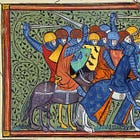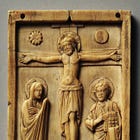My last essay brings us to the end of the Early Middle Ages (c. 500-1000 CE). Going forward, we enter the High Middle Ages (c. 1000-1300s CE).
The early Middle Ages have been known to historians as the “Migration Period.” It’s also famously titled the “Dark Ages.” Although, we’ve seen so much growth and development, it’s hard for me to see this title as accurate.
The themes have been the decline of the Roman Empire ushering in a new age of migration and the burgeoning of new kingdoms and states. We saw society go from urban with an international style of living to a more localized, rural scene and back again. We’ve seen paganism turn toward religion, both in the Christian and Islamic traditions and a blending of old traditions and customs with new beliefs and ideas. We’ve seen empires rise and fall, divide and transform. I still hold firm that my new term the “Medieval Imperial Tripod” is standing strong: the Byzantine empire in the East, the Islamic empire scattered about but rooted deep, and Latin Christendom in Western Europe.
This window of time was not dark in any stretch of the imagination. We see the foundations of Europe being laid. The great states such a France, Germany, and England were born. We see two of the main world religions taking root and shaping society and mindsets. We see the old classical ideal of late antiquity being fused with Germanic customs and peoples, then being mixed with eastern influences and Islamic ideas and intellectualism, all of it birthing new identities. We see international trade come to a screeching halt, then slowly opening back up to where we have several dominant hubs of Mediterranean trade all over again. We saw an intellectual decline come full circle to the burgeoning of a new renaissance of thought, religion, and culture that we will see blossom in the next couple of centuries.
“The return of prosperity, the increase in food production, the rise in population, the quickening of commerce, the intensification of intellectual activity—all betokened the coming of a new age. Western civilization was on the verge of a creative explosion.” (140, Hollister)
RECAP & MVP AWARDS
Below is a brief rundown of the centuries we’ve covered. Please note: my section titled, “As Far As I Can Tell,” is a gross over simplification of what happened. It’s merely to help me remember what I researched. It by no means fully encapsulates all the significance of what happened each century. The other lists are not exhaustive either, they are merely starting points for you to dig deeper if anything piqued your curiosity.
Key Players: Roman Empire, the Persian Empire, the barbarians, the Christian religion
Notables: the decline of the Western Roman Empire, the rise and spread of Christianity, and the mass migrations of people
As Far As I Can Tell…the fourth century was about the Roman Empire officially splitting, leaving the Byzantine Empire (former Eastern Roman Empire) standing on its own, and Christianity was getting its sea legs
MVPs Awards (significant people, events, and concepts to study further because they’re fascinating and worth your time): the Byzantine Empire, the Persian Empire, the barbarians (Alans, Goths, Vandals, Seuvi, Burgundians, etc.), Emperor Constantine, Edict of Milan 313 CE, and Council of Nicaea 325 CE
Key Players: the Christian Church, the barbarians (Visigoths, Ostrogoths, Vandals, Burgundians, Seuvi, Alemanni, Salian Franks, etc.), Attila and the Huns
Notables: the sacking of Rome by the Visigoth Alaric (410 CE), the Vandals in North Africa taking the Roman port cities of Hippo and Carthage (430-31 CE), the growing popularity of monasteries, the return of medieval society to an agrarian rural lifestyle, the Council of Chalcedon (451 CE), and the official end date of the Western Roman Empire (476 CE; when the Goth Odoacer captured the child emperor and declared himself king of Italy)
As Far As I Can Tell… the fifth century was all about the barbarian migrations turning into newly established kingdoms and the Christian Church working out some very important doctrinal disputes
MVPs Awards: ethnogenesis, the newly established barbarian kingdoms (listed above), Attila and the Huns, early monasticism, Alaric the Visigoth, Theodoric the Ostrogoth, Odoacer leader of a Goth coalition, Aetius (I didn’t mention him in my essay due to time, but his life is a fascinating one), Pope Leo I, Arian Christianity (the sect much of the Barbarians followed), Emperor Theodosius, and King Vortigern of the British Isles
Key Players: Emperor Justinian, Christian Church, the Frankish Kingdom, the Persian Empire, Pope Gregory the Great, St. Benedict, King Clovis
Notables: Justinian’s Codex setting up a legal example that future politics would continue to draw upon, Council of Constantinople (553 CE), the establishment of the Merovingian dynasty and the Frankish Kingdom, the establishment of the Rule of St. Benedict setting the standard for medieval monasticism, the Justinian Plague (541 CE)
As Far As I Can Tell…the sixth century was predominantly about the ongoing development and influence of monasticism, the formation of the Frankish kingdom and its relationship with the Christian Church (which also set the tone for future theocratic monarchical rule)
MVPs Awards: Justinian and Theodora, Nika Riots, Justinian Plague, St. Benedict, Pope Gregory the Great, Persian King Khosrous I and Zoroastrianism, Benedictine monasticism, Clovis and the Merovingian Dynasty, King Arthur, Celtic Christianity in Ireland, and the Lombards in Italy.
On a side note: I wrote a paper this semester in grad school focused on six historians from the sixth century, comparing their differing perspectives. These men’s writing straddled the divide between Classical historiography and Christian historiography. They were Procopius, Cassiodorus, Boethius, Isidore of Seville, Gregory of Tours, and Gildas. Please look them up!
Key Players: Mohammed and Islam, Umayyad dynasty, Byzantine Emperor Heraclius, Christian Church and monasticism
Notables: The establishment of the Islamic religion, Arab conquests and Islamic Empire, Anglo-Saxon kingdoms in Britain, the Synod of Whitby (664 CE), the “Mayors of the Palace” in Merovingian Francia (mainly Pepin II slowly gaining more power and influence in Francia)
As Far As I Can Tell… the seventh century saw the three official heirs of the Roman Empire: Islam, Byzantium, and Western Christendom begin to solidify
MVPs Awards: Mohammed, Mayors of the Palace in Francia, Isidore of Seville, Heraclius, Greek Fire, Visigothic Spain, Henri Pirenne (who created the famous Pirenne’s Thesis)
Key Players: Medieval Imperial Tripod (Byzantium, Islamic Empire, and Western Christendom), Carolingian Dynasty, and St Boniface
Notables: Arab conquests, the transfer of power from the Umayyad caliphate to the Abbasid caliphate, the establishment of Cordoba as a new Islamic hub, the Iconoclasm Heresy, Pope Gregory II and St. Boniface conspiring together to establish a symbiotic relationship between the papacy and the Frankish kingdom, Pepin the Short being crowned king establishing the Carolingian Dynasty, Charlemagne the “Founder of Europe” being crowned Holy Roman Emperor, and Carolingian Renaissance
As Far As I Can Tell…the eight century was momentous because it was the time when the medieval imperial tripod reached an equilibrium—Western Christendom identified as a separate entity apart from its Byzantium counterpart, creating a third leg and stabilizing the medieval imperial tripod.
MVPs Awards: Charles Martel, Harun al-Rashid, iconoclasts versus iconodules, St Boniface, Pepin the Short, Charlemagne, Carolingian Dynasty, theocratic monarchical rule, Muslim Cordoba, Alcuin of York, the Venerable Bede, Aachen (Charlemagne’s capital which became an elite school for rhetoric, religion, and liberal arts)
Key Players: the Vikings stole the show this century, but also…the Carolingians, Islamic Empire, Byzantium, and Western Christendom
Notables: feudalism (and the debate on whether it actually existed or not)
As Far As I Can Tell… the ninth century was all about the Vikings
MVPs Awards: Empress Irene, the Bulgars, the Tahirids (another Islamic dynasty), the Byzantine Macedonian dynasty, the Golden Age of Byzantium, Emperor Leo V (Michael II, Michael III, Basil, Eudokia, and all that mess), Louis the Pious, Treaty of Verdun (843 CE), Medieval Warming Period/Medieval Climactic Anomaly, Vikings (Swedes, Norwegians, and Danes), Mercia, Wessex, King Alfred the Great, the Great Viking Army and the Battle at Edington (878 CE), the Treaty of Wedmore
TENTH CENTURY
Key Players: Byzantine Empire, Islamic Empire, Western Christendom, the Duchy of Normandy, Cluny Abbey
Notables: “the birth of Europe,” Islamic Empire fragmentation, Islamic Golden Age, the German/Holy Roman Empire rising to its preeminent place, Italians cities exploding, the establishment of Normandy, the spread of Christianity and conversion of masses, the establishment and rise of Cluny Abbey, the Golden Age of Monasticism
As Far As I Can Tell…the tenth century saw the “birth of Europe,” the crystallization of the symbiotic relationship between Church and state, and the beginning of a re-awakening of the medieval mind
MVPs Awards: Vikings, Magyars, Medieval Warming Period (MWP), Islamic Golden Age, Muslim caliphates (Abbasids, Fatimids, Umayyads, and Buyids), Al Azhar (the first university), Sufism, the Mamluks, Ottonian Dynasty, Ottonian Renaissance, Roswith of Gandersheim (first female poet), Italian cities (Genoa, Pisa, Venice), Rollo the Viking, Edward and his sister Aethelflaed (Lady of the Mercians), Danelaw and Danegeld, Athelstan, famous Battle of Brunanburgh, Cluny Abbey, sæculum obscurum (to learn of the “Dark Ages” of the papacy), all the different monastic orders (please see list in essay), Birka Female Warrior, Freydis Eiriksdottir, Theophano (wife of Otto II), Marozia, Abbess Mathilda, the development of castles and knights








